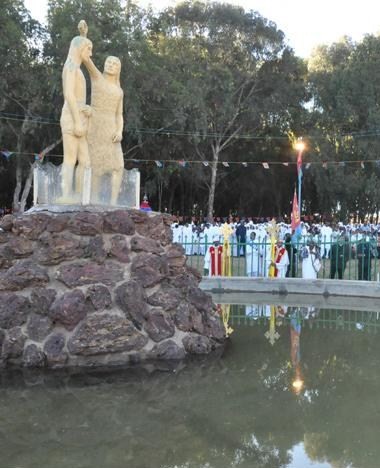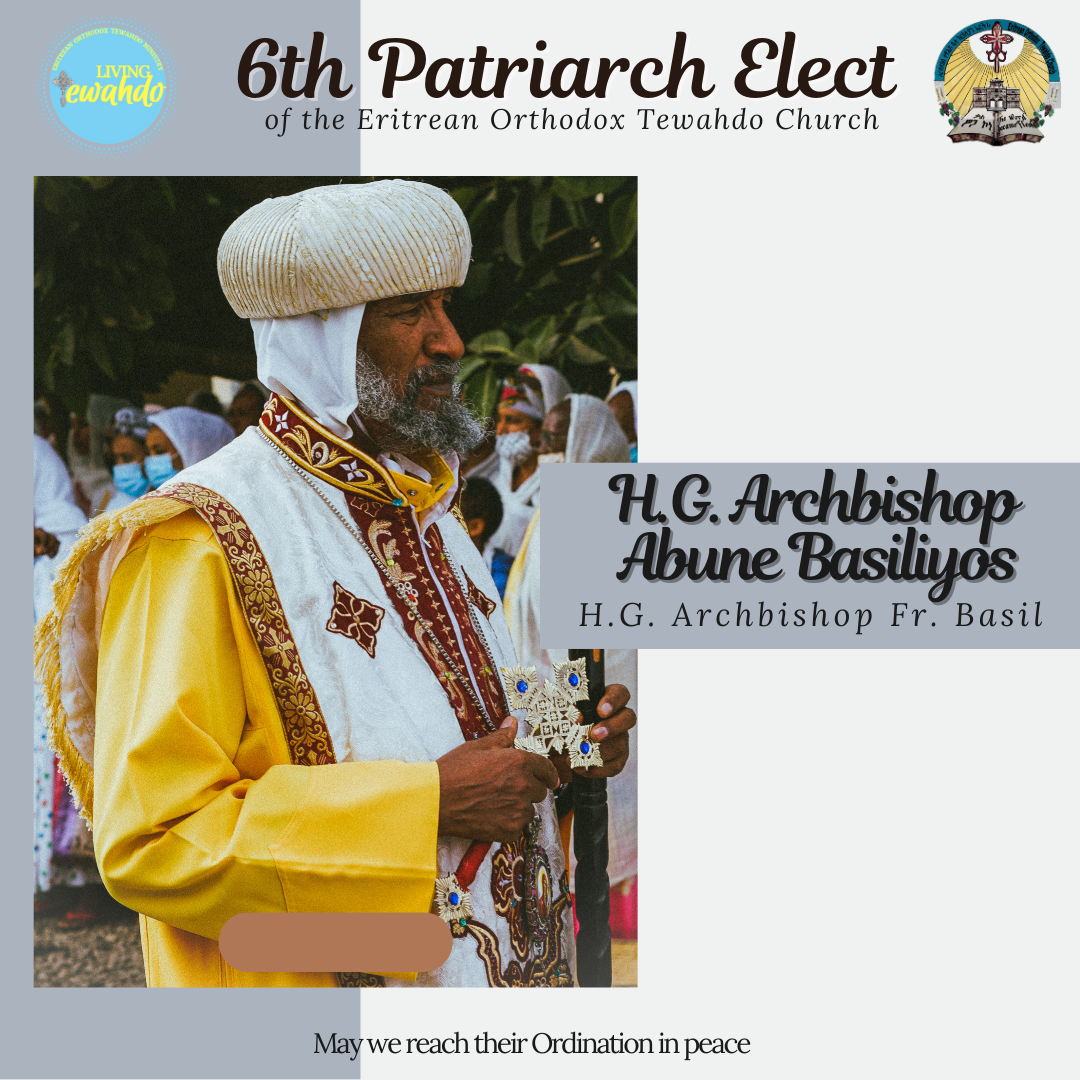On this day our Lord Jesus Christ was baptized in the River Jordan by John the Baptist. The festival which is kept on this day is called Timqet Ge’ez word meaning “immersion in water. The word also denotes epiphany which is driven from the Greek word epiphaneia meaning “appearance” “Epiphany,” which is, being interpreted, “the appearance of the Godhead,” because on this day appeared the mystery of the Holy Trinity. The annual Timket celebration is held across Eritrea on Tiri 11 Geez calendar (January 19 G.C) with processions of priests carrying of the Ark of Covenant (Tabots), escorted by thousands of believers. The day is observed in commemoration of Christ’s baptism in the Jordan River. Timket is one of the major feasts of our Lord and Savior Jesus Christ and is a public holiday that is celebrated beautifully.
The Mystery of the Holy Trinity Revealed
On this day appeared a great miracle, the mystery of the Holy Trinity the Father saying “This is my Son Whom I love, in Whom I am well pleased. Hear Him.” And the Son was standing in the Jordan, and the Holy Spirit, in the form of a dove, was standing on Him, even as John the Baptist was a witness of this, saying, “Our Lord Christ, having been baptized, went up out of the water; and straightway the heavens were rent, and the Holy Spirit came down upon Him like a dove. And a voice came from heaven, saying, This is My Son Whom I love, with Whom I am well pleased. Hear Him.”
At this hour Lord revealed Himself, (now, for a period of thirty years He had not revealed Himself to anyone), and on this day He revealed Himself to the children of Israel. John the Evangelist was a witness, and John the Baptist was a witness to Him before the people, and he openly said unto them, “This is the Lamb of God Who taketh away the sin of the world.” His pronouncement I do not understand, and only that He appeared unto Israel, and because of this, I came out to baptize Him with water. And at this festival, the glory of Christ appeared, as that of the Son of God, and His own glory as the Lamb of God, Who taketh away the sins of the world. After Christ was baptized, the three persons of Holy Trinity (Father, Son, and Holy Spirit) have been revealed distinctly.
- The voice of God the Father came from heaven saying, “This is my Son, whom I love; with him, I am well pleased”.
- God the Son, incarnate in the human body, was baptized by St. John in Jordan River.
- And the Holy Spirit descended in the form of a dove and perched on the Son. (Matt. 3:13-17)
The opening of heaven: right after Christ was baptized, the heavens were opened indicating that we have been redeemed from Adam’s sin that led to the closure of the heavens through believing in Jesus Christ and baptism. This reveals the spiritual value baptism has as an opener of the heavens. (Galatians 3:27).
The festive lasts two days, the 18th (the eve of Timket) and the 19th 0f January, even extending to a third day where there is Tabots dedicated to Archangel Michael whereby celebrated the feast of the miracle of Jesus at the wedding of Cana.
Though Timket is celebrated on January 19, the season, according to the church’s tradition, covers the period from the eve of the festival to the start of the three-day fast observed in commemoration of the fast the people of Nineveh observed to avert God’s wrath. During the Timket season, the church praises the Lord reciting chants and readings pertaining to the birth, circumcision, and baptism of Christ as well his miracle at a wedding in Cana of Galilee. (Luke 2:21; John 2:1-11)
The Efficacies of Baptism
Baptism is one of the seven sacraments through which a believer receives an invisible grace under the form of an outward sign visible or audible. Through baptism, offer being dipped into water three times in the name of the Father, the Son and the Holy Spirit, a person is born again and accepted in to the membership of the church. As soon as the child is born, the priest makes the proper calculation as to when the child is to be baptized and notifies the blood parents. In case of a boy, baptism takes place forty days after birth; with a girl eighty days after birth.
Baptism may be administered any time if the child is in danger of dying. After the newborn is baptized the priest can secrete the oil through his prayer and anoints the child; he also blows into its face, signifying the giving of the Holy Ghost. The baptismal rite is not repeated upon the feast of Epiphany or on repentance or any other occasion. Baptism by laymen, even deacons, is not allowed under any circumstances. It is the task of only a priest, a bishop or the Patriarch.
Verses to note:
• Through baptism, we receive the second birth, which is of Water and the Spirit. /Jn. 3:5–8/
• In baptism there is forgiveness of sins. /Acts 2:37, 38/
• Baptism is dying with the Lord Jesus Christ and Rising with Him. /Rom.6: 23, Phil.3:10, Col. 2:21
• In baptism there is newness of life. /Rom. 6: 4/
• In baptism we put on Christ. /Col. 3:27/
• In baptism we became members of the church. /Col. 2: 11 – 12/
Timket Celebration in Eritrea
In Eritrea, the day is particularly celebrated in a colorful manner in Asmara. The gathering at Mai Timket, a wide water basin with a statue depicting John the Baptist baptizing Jesus Christ erected in the middle, which has always been a landmark event, both for locals and foreigners.
Thousands of the Christian faithful attend early morning Mass featuring preaching, ceremonial dances of the priests and spiritual songs.
The ceremonies and rituals of Timket, which offer a direct window onto the world of the Old Testament, actually commence early in the afternoon on Timket Eve. The tabot (a replica of the Ark of the Covenant) is carried by priests from each church to the body of water, accompanied by the faithful and members of the clergy chanting, dancing, beating drums and waving sticks (meqomyas) . As evening falls, the priests and the gathered crowd participate in an overnight vigil and Mass around the Arks.
Following Mass, the Patriarch of the Eritrean Orthodox Tewahdo Church dips his cross in the pool to bless the water. Three candles are lit and floated on a water of wood in the pool, symbolizing the Holy Trinity. The water is then blessed and sprinkled towards the assembled congregation, this is to serve as a reminder of baptism – the remission of sins and that through the baptismal waters a person accepts the obligations of Christian commitment. 
After the ceremony is concluded, the celebration reaches its climax as everyone charges forward to the water basin to fill their containers with the blessed water, to later take it home for private devotions. One of the events that add color to the festival actually takes place after the ceremony at Mai Timket. The tabot of each church in Asmara is paraded in a long procession through the streets with the priests dressed in their elaborate robes followed by huge crowds.
When moving the tabot, which is rarely seen by the laity and is accorded extreme relevance, it is reverently wrapped in rich cloth and carried on the head of the priest with colorful ceremonial umbrellas to shade it. Children from the city’s different Sunday schools sing various hymns while accompanying the tabots to their respective churches. Only the Tabots of St Michael remains a further night there since its feast is on the following day, associated with the first miracle of Jesus, the Wedding of Cana. 
Because of this the festival this day is a great festival among all Tewahdo Christian believers, and they cleanse themselves with holy water in imitation of the Baptism of our Lord Christ; and they received during this festival remission of their sins, provided that they continue in the purity which they have received. Therefore it is meet for us to keep, and serve, and glorify the abundant grace of our God and Redeemer Jesus Christ, Who became man for our sakes and delivered us from our sins.
Glory to be God!



